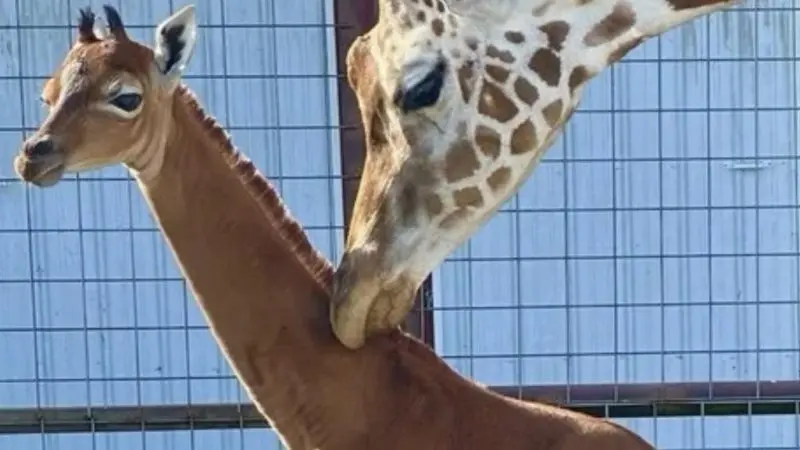
A spot-free giraffe sounds like something out of a children’s book, rather than a real creature. However, a unique little one has recently made its debut in the world. In late July, a baby reticulated giraffe was born at the Brights Zoo in Tennessee, and it has completely solid brown fur—without a single spot. Scientists note that this little one is likely the only one of its kind. Spotless reticulated giraffes are an extremely rare occurrence. According to experts, there are no other known examples of this species existing without spots anywhere on Earth.
David Bright, the zoo director, told Sciencealert that they have been in touch with zoo professionals across the country since the day this remarkable baby giraffe was born. However, none of them are aware of a similar case, at least in recent years. There are historical reports of a spot-free reticulated giraffe born in captivity in Japan during the 1970s, but no photographs of that animal have surfaced online.
The spots on a giraffe serve as camouflage for protection. The characteristic patterns on the dark fur of a reticulated giraffe are not random in design or shape; they are inherited from the mother. It is believed that these distinctive patterns provide camouflage for the animal. Therefore, individuals born without spots may struggle to hide from predators in the wild. One study found that giraffe calves with larger, irregularly shaped spots have better survival chances after a few months of life. However, this was merely a correlation, and spotted patterns may also play a role in visual communication or temperature regulation. Given these risks, it’s quite possible that a spot-free reticulated giraffe will fare better in captivity.
Just a few weeks after its birth, the little one has already grown to 1.8 meters tall. As for the name of this unique spot-free giraffe, the zoo staff is currently working on selecting one. They have carefully narrowed it down to four potential options in Swahili: Kipekee, meaning “unique”; Firayali, meaning “unusual”; Shakiri, meaning “she is the most beautiful”; and Jamella, meaning “one extraordinarily beautiful.” The zoo staff has reached out to the public for help in choosing the best name.
Mr. Bright hopes that the recent media coverage of this remarkable spot-free giraffe will draw much-needed attention to the conservation of these animals as a whole. For decades, giraffes have been moving toward “quiet extinction,” primarily due to unchecked habitat loss, civil unrest, and poaching. Over the past 30 years, the population of these animals in Africa has plummeted by 40%, leaving only 16,000 reticulated giraffes. Ironically, the tallest mammals on Earth have previously gone unnoticed. Until 2016, researchers were unaware that there were four distinct subspecies of these animals. Therefore, it can be argued that not only is the lone female without a spotted pattern born in Tennessee unique, but so is the entire lineage of these amazing mammals.
